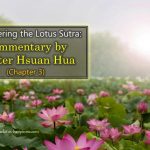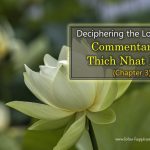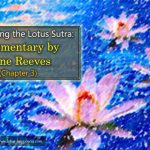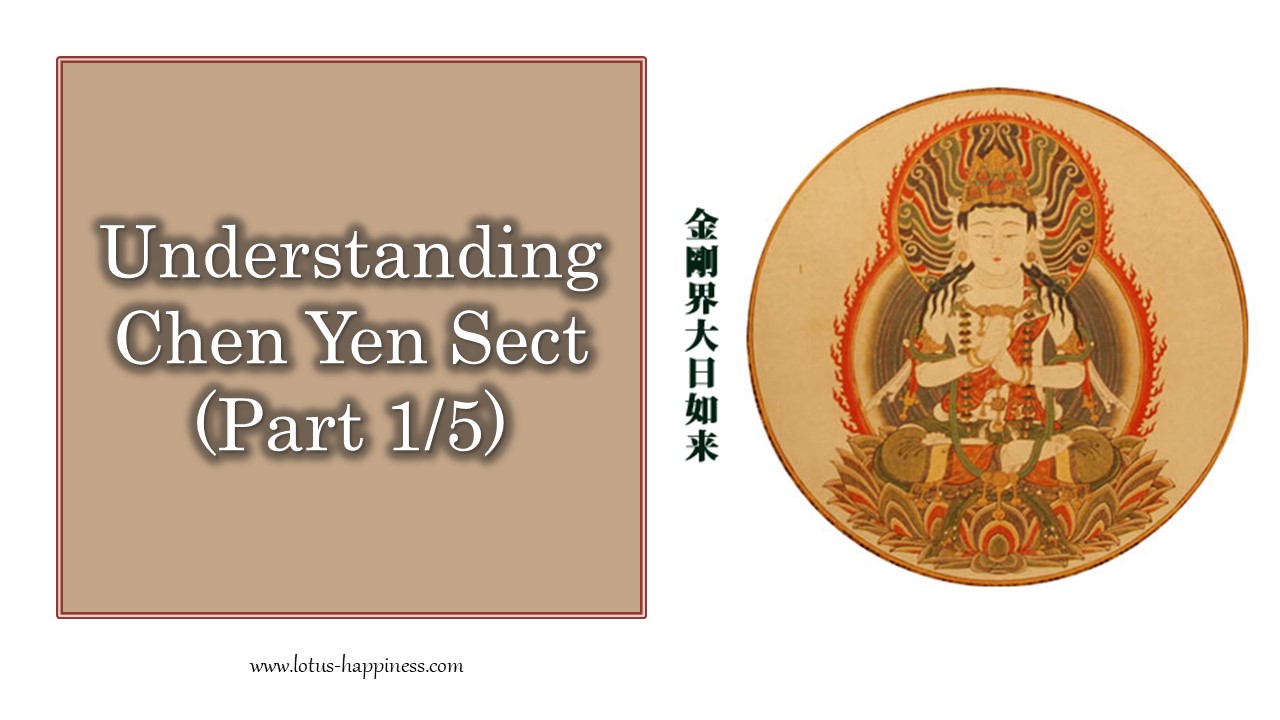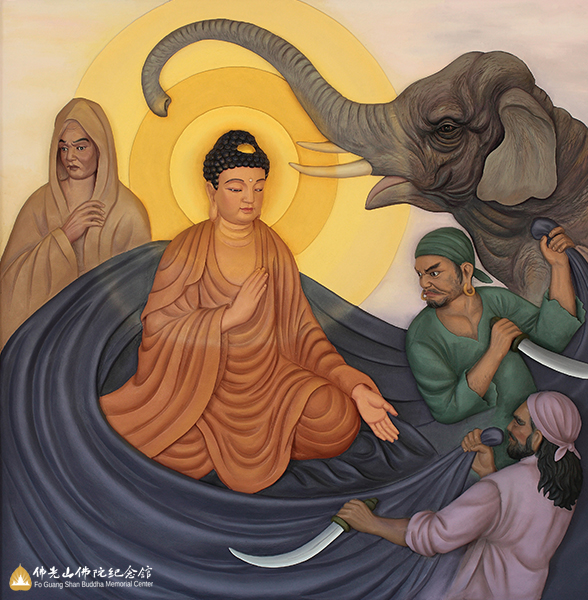Deciphering the Lotus Sutra: Commentary by Master Hsuan Hua (Chapter 2)
Lotus Sutra:
At that time the World Honored One arose serenely from samadhi and told Shariputra, “The wisdom of all the Buddhas is extremely profound and unlimited. The gateway to this wisdom is difficult to understand and difficult to enter. It cannot be known by any of the Hearers or Pratyekabuddhas.
Commentary:
The previous prose and verse sections were an introduction to the Sutra, setting forth the Sutra’s causes and conditions. Now that the causes and conditions have been related, we will proceed to explain the second chapter which is called Chapter Two: Expedient Devices.
A device is a method, and expedient means effective. This type of method is a provisional dharma, not a real one. It is a provisional device designed for temporary use. Real means that it is forever unchanging, forever usable. However, if you begin by speaking the unchanging, real dharma, no one can understand it. That is why the Buddhas of the ten directions artfully set forth expedient Dharma-doors and “bestow the provisional for the sake of the real.” Later, they “open the provisional to reveal the real.”
“Bestowing the provisional for the sake of the real” means that, for the sake of realizing Buddhahood, the Hearer and Pratyekabuddha Vehicles are taught. After that, the Bodhisattva Vehicle is taught. The ultimate destination, however, is the Buddha Vehicle. The Buddha Vehicle is real. The Hearer and Pratyekabuddha Vehicles are provisional, taught for the sake of realizing Buddhahood. Small Vehicle Dharma is taught provisionally. Later, living beings are led to return to the Great Vehicle, the Buddha-fruition. That is what it means by “bestowing the provisional for the sake of the real.”
Next, let us consider what is meant by “opening the provisional to reveal the real.” At the very beginning, when the Buddha taught the Hearers and Pratyekabuddhas, he said, “This Dharma-door is the very best. It is incomparable Dharma. Nothing can compare with it.” The Small Vehicle people cultivated in accord and certified to the first, second, third, and fourth fruition of Sagehood. They were satisfied with just a little. They thought that was what the Buddhadharma was all about. They did not go forward or seek to advance. They stopped at a Transformed City.
The analogy of the Transformed City will be discussed when we come to Chapter Seven. Those of the Two Vehicles felt that they had expended considerable energy in their cultivation. They had practiced all kinds of ascetic practices in order to certify to the attainment of the Sagely fruition. They didn’t know that there was still the Buddha Way to be realized. Above, they did not seek the Buddha Way, and, below, they did not teach and transform living beings. They were “independent Arhats.” Having realized the Buddha Way themselves, they paid no attention to whether other living beings realized it.
For that reason, the Buddha began to “open” up the provisional dharma. He said, “The doctrines I previously explained to you were not the utmost Dharma-doors. Although you have certified to the Sagely fruition, it’s not the ultimate position. You still have to return from the small and go towards the great. You must turn away from the Small Vehicle and go towards the Great Vehicle. You ought to walk the Bodhisattva path and cultivate the Six Paramitas and the Ten Thousand Conducts, the dharmas of the Great Vehicle.” Thus, the Buddha destroyed the provisional dharmas by making them obsolete, and he revealed the genuine doctrine.
At that time, when this chapter was spoken, the World Honored One, the Buddha, the one honored by gods and humans, both in and beyond the world, arose serenely from samadhi. Shakyamuni Buddha had entered the Samadhi of the Station of Limitless Principles. Now, he emerges from that concentration, and he does so serenely, which means peacefully and with self-mastery. He wasn’t like those who, when finished meditating, immediately stretch out their painful legs and backs, roll their necks, and flex their shoulders. That’s not being serene. It shows a lack of good manners, besides. Serene means calm, feeling one’s entire body to be comfortable. It means no pain in the legs or in the back. The Buddha arose from samadhi and he was just about the same as before he had entered it. He didn’t notice that his legs were uncomfortable.
And told Shariputra: He arose and, since no one asked him, the Buddha spoke without being requested to speak. Why did he speak to Shariputra? It was because among the assembly of Hearers, Shariputra was foremost in wisdom. He was the most intelligent. Within the space of a single week, Shariputra had completely penetrated the entire storehouse of Dharma. While still inside his mother’s womb, Shariputra won debates with his uncle. Shariputra’s uncle was a great debater. He was an excellent speaker who possessed unobstructed eloquence.
However, when Shariputra’s mother was pregnant with Shariputra, she borrowed Shariputra’s wisdom and used it to defeat her older brother. Shakyamuni Buddha now addressed Shariputra, because he was so wise. Manjushri Bodhisattva, who spoke previously, is foremost in real wisdom, the wisdom of the Great Vehicle, whereas Shariputra is foremost in the wisdom of the provisional teaching, the wisdom of the Small Vehicle.
Shakyamuni Buddha now tells Shariputra, The wisdom of all the Buddhas is extremely profound and unlimited. It is extremely deep; it’s bottomless and so you cannot know how deep it is. It is unlimited because it cannot be reckoned. It is at once profound and unlimited. It’s a kind of wisdom that is so high and so deep that it cannot be fathomed or known by reckoning. It cannot be known through analogy. That’s what the wisdom of all the Buddhas is like.
The gateway to this wisdom is difficult to understand and difficult to enter. Since the Buddha’s wisdom is extremely profound and has no limit, how can one enter into it? How can one enter the wisdom of the Buddhas? The gate into the wisdom of Buddhas is hard to understand and to enter. It’s not at all easy to be clear about it. It’s difficult to certify to its attainment.
It cannot be known by any of the Hearers or Pratyekabuddhas. The assembly of Hearers and Pratyekabuddhas cannot understand it.
Hearers and Pratyekabuddhas belong to the Two Vehicles. Those who are born when a Buddha is in the world and who cultivate the Twelve Causes and Conditions are called Those Enlightened by Conditions. Those who are born when no Buddha is in the world and who cultivate on their own, seeing the flowers bloom in the spring and the yellow leaves fall in the autumn, and thus awaken to the Way, are called Pratyekabuddhas.
Hearers cultivate the Dharma of the Four Truths and certify to the fruition. The Four Truths are: the truth of suffering, the truth of origination, the truth of extinction, and the truth of the Way.
The Hearers and Pratyekabuddhas are the sages of the Small Vehicle. Although they have certified to the fruitions of sagehood, they cannot know the Buddha’s wisdom; they don’t understand it.
Source: CTTB


